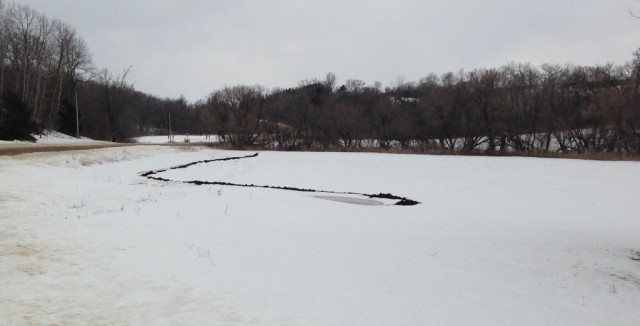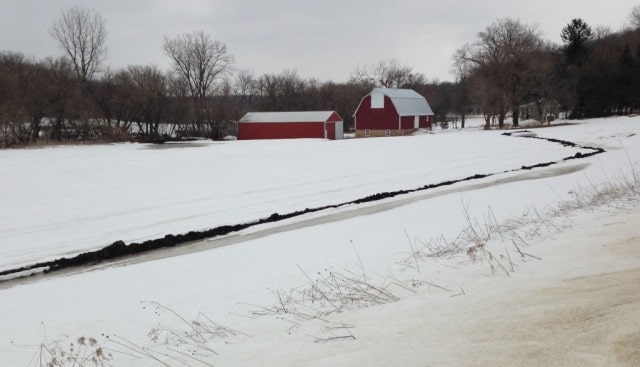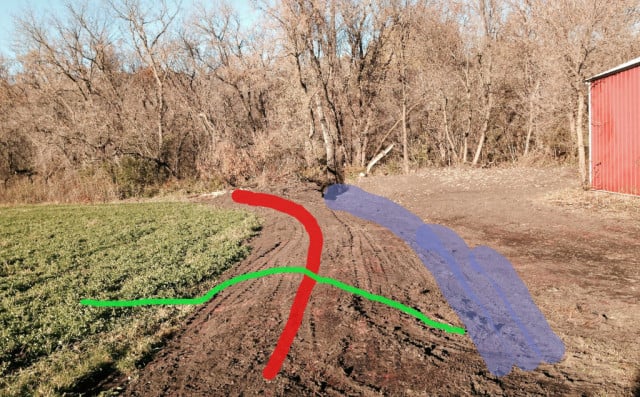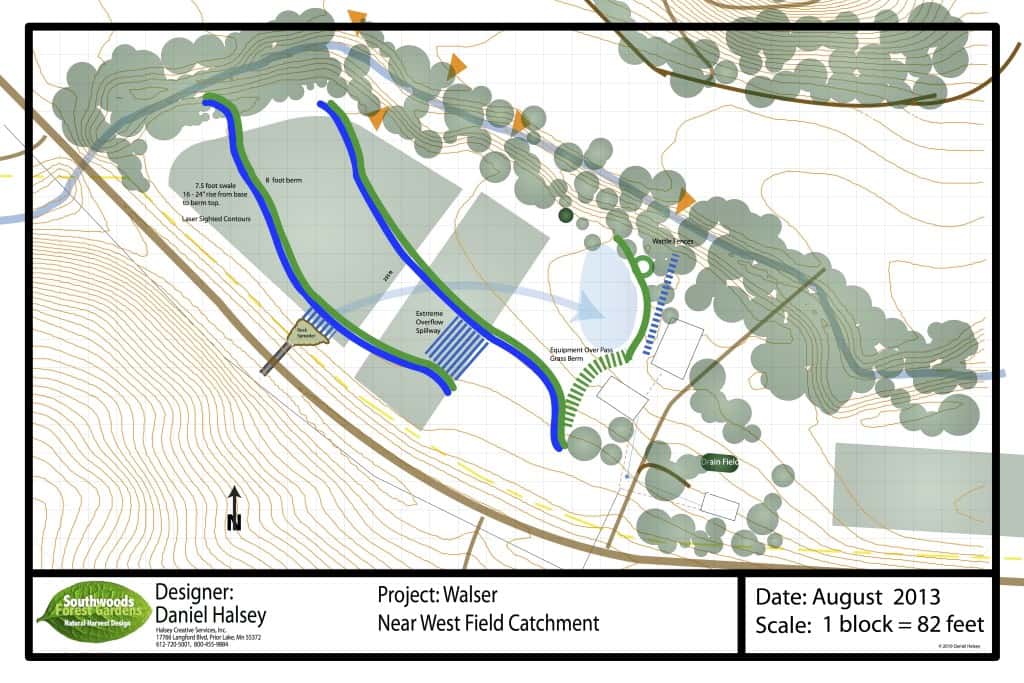Spring melt and runoff is beginning and the first test of last autumn’s keyline work is visible. As the snow melts, the upper berm becomes clearly visible. Viewed from another angle water can be seen accumultating in the swales on the uphill side of the berm – just like we wanted. I’ll continue to monitor through the spring melt, of course. It won’t be long till we can plant that berm with mixed permaculture-flavored plantings . . .
Here is the upper berm peeking through the snow.
Another view. Note how the water is collecting on the uphill side – exactly according to plan.
Gorgeous! A terrific crew of volunteers enjoyed fascinating presentations by Dan Halsey bookending a day of practical implementation of Keyline Design. Our near west field has new berms and swales and a rock (those were big rocks!) outflow by the culvert to slow and spread the flow of water during major rain or runoff events.
Here is a view of the field with the swales highlighted and the rock installation circled. I wish I had an arial photo to show the actual shape and how the berm/swale combinations follow the contour. Now we have to wait for a big rain or the spring runoff to see how it all works!
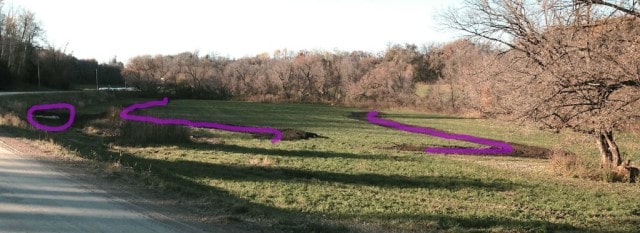
And here is the ‘Defensive Berm’ near the pole shed. The berm is highlighed with red, it stands about 12-18″ taller than the field – the exaggerated countour of the berm is shown in green. The blue marks a new and appropriatedly sloped channel for any water that does make it over the berm or into the area. It sends the water away from the viewer and into our intermittent creek.
And here’s a gallery of photos of the day.
A humongous “Thank You!” to everyone who participated. We are so lucky to have you all in our circle of friends!
A while ago I challenged folks to create solutions to the erosion and water management issues on the field just west of the barns. This Saturday we’ll begin to implement techniques we hope will address those challenges. Dan Halsey of Southwoods Forest Garden created this plan. With the help of some heavey equipment and a number of friends, we’ll be creating the rock-lined catch basin at the culvert outflow and building two swale/berm combinations and a final barrier berm.
If you want to come and join us, Dan will be giving an explanatory talk at 9:00 (with coffee and donuts, of course) then we’ll head out into the field and use a laser level and other tools to flag the field for the machines, then finish off the berms/swales with seed. Lunch will be provided and a potluck dinner and bonfire will follow. Should be a fine day to get up close and personal with keyline design.
Hope you can make it.
Four books have dazzled me this summer. Here, for your perusal and amusement, brief explications. (Thanks, Brian Wicklund, for the nudge!).
Gar Alperovitz' What Then Must We Do? (White River Junction: Chelsea Green, 2013) starts with systemic malaise: the generalized but unfocussed recognition that the system's broke and that the means to fix it are not apparent: markets and the economy are out of control, government is for sale, climate change is happening and no one says boo . . . you get it. Alperovitz argues that this has a lot to do with not just the concentration of wealth, but also the disconnect between finance, control and the real world of jobs, families and ordinary life. He sees "democratic ownership" such as coops, mutual banks and the like as ways for communities to be more directly connected with the decisions that affect them.
The End of Money and the Future of Civilization by Thomas H. Greco, Jr. (White River Junction: Chelsea Green, 2009) covers some similar ground in the obvious (to me, anyway) critique of our disasterous financial system. He usefully notes that money at present serves three distinct purposes: 1) as a means of exchange, 2) as a measure of value and 3) as a store of value. In his view these functions can be separated and accomplished by various means such as local currencies (e.g. Berkshares) to use an obvious example. Like Alperovitz (and many others), Greco values community, localism and personal connections and provides many examples. His specific suggestion of a credit clearing scheme may be beyond our grasp at the moment, but offers fascinating food for thought.
Take Back the Economy: an ethical guide for transforming our communities by J.K. Gibson-Graham, Jenny Cameron and Stephen Healy (Minneapolis: University of Minnesota Press, 2013) argumes for localism and community as a question of ethics. By framing it's explorations with the question 'How can we survive well together?' and using illustrations and exercises the book provides thoughtful pathways to greater understanding of the ethical impact of our economic behavior. For example, they demonstrate how finance obscures the personal impact of our economic choices: when we look at a t-shirt at Target we ask "Can I afford it? Do I like it? Will it work for me?" etc. all of which seem to make sense. But we don't ask, "What was the carbon footprint of getting this here? Who was involved in making it and were they fairly compensated? Was there pollution or waste of resources in making it?" – By framing our decisions in terms of money, we simply fail to see the other costs of our choices. This is but one example of the kind of thinking they apply to work, business, markets, property and finance.
Finally, I just finished Marjorie Kelly's Owning Our Future (San Francisco: Berrett-Koehler, 2012). Kelly draws a distinction between the extractive economy and what she calls a generative economy. These alternatives are deeply connected to notions of ownership and lead to very different outcomes. She identitifes five core elements of generative ownership design invoking Alexanders ideas of pattern language as a model for her analysis. Not only did I find her ideas engaging and well presented, but many of her examples were familiar to me: Organic Valley Coop, The Wild Rumpus Bookstore here in Minneapolis and the John Lewis Partnership where we liked to do business when we lived in England.
As I've explored Transition, climate change and energy issues, I've often encountered the idea of re-localization, the notion that as present global systems change, local alternatives may well prove more resilient and appropriate. The underlying argument being that the energy and carbon cost of global business may be unsustainable. Taken together, these books offer an entirely different path to a similar conclusion based on ethics rather than limits and demonstrating repeatedly why human-scale, community economic systems rooted in personal relationships and particular places offer not just a possible way to weather uncertain times, but an attractive, positive alternative to a present system careening blindy towards destruction.
– – – – –
N.B. My local bookshop, Birchbark Books, is where I knowingly pay more than the Amazon price to support a local business and community asset. If they don't have them in stock, they can get these books for you.

